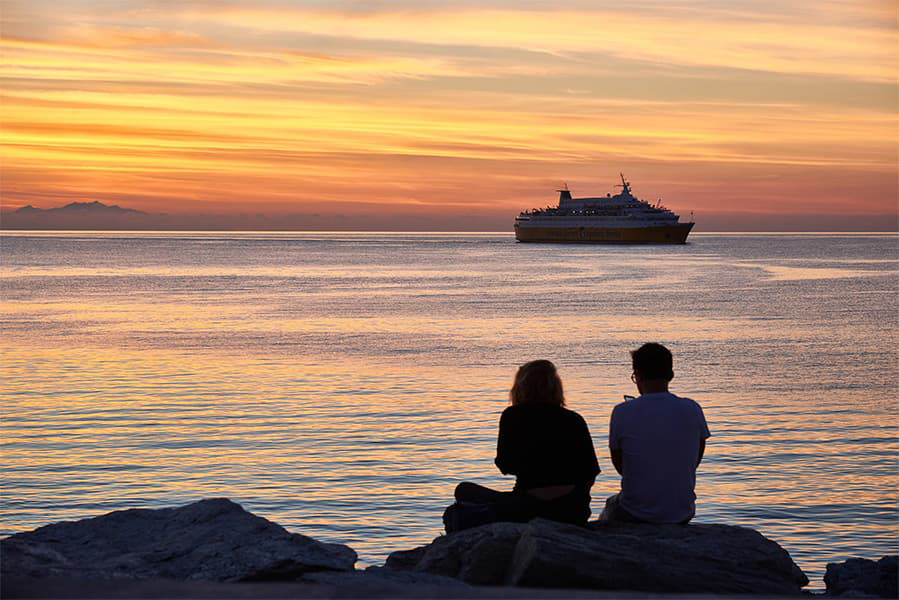Mali Losinj - Zadar
Ferries to Croatia
Mali Losinj - Zadar
Ferries to Croatia

On average there are 2 weekly sailings between Mali Losinj to Zadar. This ferry route is operated by
The Mali Losinj Zadar ferry typically departs from Mali Losinj at around 09:30.
Mali Losinj Zadar Ferry sail durations on this ferry route can take around 2h 15m. The fastest sailings are approximately 2h 15m. Sailing times can vary, durations often differ between ferry operators and can be impacted by weather conditions.
On average there is around 2 weekly ferry sailings from Mali Losinj to Zadar. These sailings are provided by Krilo Kapetan Luka. Please keep in mind that ferry timetables may differ by season.
Mali Losinj Zadar ferry prices typically range between 11.0 €* and 44.0 €*. The average price is typically 22.0 €*. The cheapest Mali Losinj Zadar ferry prices start from 11.0 €*. The average price for a foot passenger is 22.0 €*.
Pricing will vary depending on number of passengers, vehicle type, route and sailing times. Prices exclude service fees.
The distance between Mali Losinj to Zadar is approximately 59.8 miles (96.3km) or 52.0 nautical miles.
No, ferry operators currently do not allow cars to travel on sailings between Mali Losinj and Zadar
Yes, foot passengers can travel with
Pets are currently not allowed on board the ferries from Mali Losinj to Zadar.
More routes than anyone else.

Compare fares, times & routes in one place.
Change plans easily with flexi tickets.

Book e-tickets & manage trips in-app.
Live ship tracking & real-time updates.

Top-rated customer support when you need it.
| Mali Losinj - Zadar Route summary | ||
|---|---|---|
| Departure Country | Croatia | |
| Destination Country | Croatia | |
| No. of Operators | 1 | |
| Operators | Krilo Kapetan Luka | |
| Average Price | 22 €* | |
| Average Weekly Sailings | 2 | |
| Average Sailing Duration | 2h 15m | |
| First Ferry | 09:30 | |
| Distance | 52 nautical miles | |
* Prices subject to change, pricing is taken from last 30 days, last updated 2024-11-05.
Found on the western coast of Croatia, bordering the Adriatic Sea, Mali Losinj is a town in the Primorje-Gorski Kotar. There are many ferry routes leaving from the port, with the vast majority heading to other tourist resorts belonging to Croatia. Regarded as Croatia’s best kept secret, Mali Losinj offers a landscape that greatly differs from the quintessential summer holiday destination. Instead of beaches littered with tourists and bars frequented by young Europeans, Mali Losinj hosts beautiful quaint houses surrounded by endless green hills. Losinj hasn’t been flooded with tourists like much of Croatia, yet the beach is a popular spot for visitors because of the white sand next to clear blue waters. For a real treat, head to Cikat Bay, the most protected and picturesque area, where dolphins can be seen swimming relatively near the coastline. As well as the sandy beaches, there are pebble beaches that are perfect for a day relaxing in the warm weather whilst sampling the delicious food and drink. In the unlikely event that the climate doesn’t reach the usual high temperatures, the museum is a highly regarded tourist attraction and is well worth a visit. Part of the reason Mali Losinj attracts less visitors than other Croatian resorts is the difficult accessibility. To reach the region, visitors need to get the car ferry then drive for an hour, so it’s not the most conveniently placed location but the journey makes it more enjoyable. The town is relatively small so it can be covered entirely by foot, though there is also a bus service in operation.
Zadar is a city in Croatia on the Adriatic Sea. It is the centre of Zadar county and the wider northern Dalmatian region. Zadar gained its urban structure in Roman times; during the time of Emperors Julius Caesar and Augustus, the town was fortified and the city walls with towers and gates were built. On the western side of the town were the forum, the basilica and the temple, while outside the town were the amphitheatre and cemeteries. During the Middle Ages, Zadar had fully gained its urban aspect, which has been maintained until today. In the 16th century, Venice fortified the town with a new system of defensive walls on the side facing land. In the first half of the 16th century, architectural building in the Renaissance style was continued. Since World War II the city has developed as a strong economic and tourist centre.